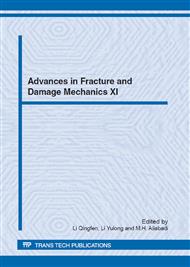p.173
p.177
p.181
p.185
p.189
p.193
p.197
p.201
p.205
Monitoring Fatigue Cracks and Stress Intensity Factors Based on the Distributed Dislocation Technique
Abstract:
We present a method for crack detection and stress intensity factor measurement in plate structures by using strain gauges and applying the dislocation method. The presented approach is based on the strain measured at different locations on the surface of the structure. This allows both the identification of crack position parameters, such as length, location and angles with respect to a reference coordinate system and the calculation of stress intensity factors (SIF). The method solving the direct problem is based on the idea of representing the crack by a line of point dislocations. The latter are formed by applying a constant displacement between adjacent points located at either side of the crack. Thus, the approach is based on the weighted superposition of elastic Greens functions representing the strain field due to the presence of a crack, where the weights are being identified by inverse problem solution. Since the strain fields are controlled by both external loads and the crack growth the unknown parameters are crack length, position and inclination as well as loading quantities. The particle swarm algorithm (PSO) came out to be most suitable for parameter identification in a high dimensional space.
Info:
Periodical:
Pages:
189-192
Citation:
Online since:
November 2012
Authors:
Price:
Сopyright:
© 2013 Trans Tech Publications Ltd. All Rights Reserved
Share:
Citation:


